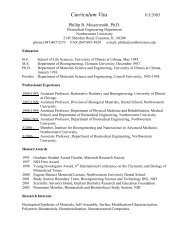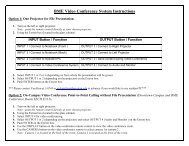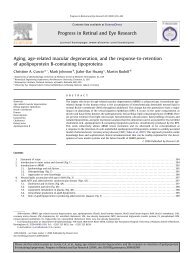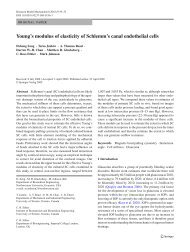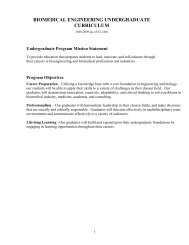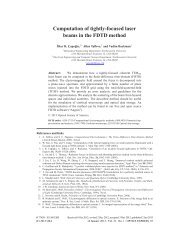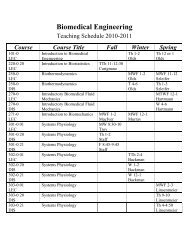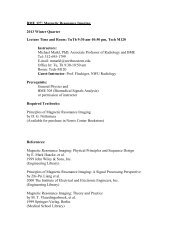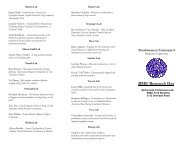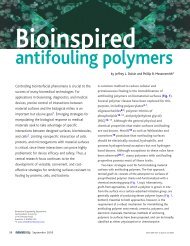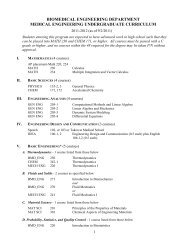BIOMEDICAL ENGINEERING AT NORTHWESTERN UNIVERSITY
BIOMEDICAL ENGINEERING AT NORTHWESTERN UNIVERSITY
BIOMEDICAL ENGINEERING AT NORTHWESTERN UNIVERSITY
Create successful ePaper yourself
Turn your PDF publications into a flip-book with our unique Google optimized e-Paper software.
<strong>BIOMEDICAL</strong> <strong>ENGINEERING</strong> <strong>AT</strong> <strong>NORTHWESTERN</strong> <strong>UNIVERSITY</strong>byChristina Enroth-CugellTo define the field of biomedical engineering precisely is difficult, but at least two componentsare easily recognized. One is biomedical tools, that is, the development of instruments, devicesand systems that contribute to the quality and sophistication of patient care and to the techniquesused in clinical and research laboratories. A second area may be described as the interaction -- inthe classroom and in the laboratory -- between engineers and life scientists who together seekdetailed, quantitative descriptions of the dynamic properties of biological systems.The origins of biomedical engineering at Northwestern can be traced back to 1943 when Paul E.Klopsteg, President of Central Scientific Company, made a donation to Northwestern for thepurpose of making possible "certain developmental activities at the University." Several passagesin the document that outlines the purpose and administration of these funds clearly show thatKlopsteg foresaw the potentials of interaction between physics and engineering on the one handand biology and medicine on the other, in teaching as well as in research. The passage whichsuggests that it would be valuable to introduce "a course in physical laboratory methods, and theuse of instruments and apparatus in the measurements and control of physical phenomena, withreference to experimental problems in chemistry, biology, medicine and other sciences"constitutes but one example of Klopsteg's suggestions for biomedical engineering endeavors atNorthwestern. Somewhat later, Paul Klopsteg became Professor of Applied Sciences andDirector of Research at Northwestern's Technological Institute, and in 1945 he became involvedin prosthetics research (1), one form of biomedical engineering.However, if asked today when and how Biomedical Engineering at Northwestern's School ofEngineering took hold, the nineteen fifties and Richard W. Jones, professor of electricalengineering at Northwestern from 1941 to 1971, immediately come to mind. A flavor of thespirit in which Professor Jones initiated biomedical engineering in Northwestern's EngineeringSchool, can be gleaned from a passage in a talk he gave in 1966 at the meeting of the AmericanAcademy of Physical Medicine and Rehabilitation:"To many individuals the ideas to which we have referred" (the interactionbetween engineering and life sciences) "connote instruments, recorders, andcomputers, devices that have appeared in profusion in clinical research. Ofpossibly greater importance, however, are the concepts, the theoretical structures,that diffuse between disciplines to profoundly affect our ways of thinking aboutbiological processes. This flow of ideas has led to many refinements in our viewof physiological systems, and to the introduction of mathematical models andwhat might be described as theoretical physiology."It was in this field of "theoretical physiology" that biomedical engineering at Northwesternstarted and grew during the first few years. Medical instrumentation "joined the club" somewhatlater and the two components then flourished side by side.
Shortly after the end of the second World War the chairman of the Electrical EngineeringDepartment, Dr. John F. Calvert, arranged a series of demonstrations of the analog computerfacilities on the Evanston Campus. These demonstrations were directed towards the MedicalSchool faculty because Dr.Calvert felt that there might be some areas of common interestbetween the two schools. Among the members of the Medical School faculty who attended wereProfessors John Gray and Fred Grodins of the Department of Physiology; Professor Jones wasone of the participating engineers.Drs. Gray and Grodins were involved in quantitative physiological studies (something ratherunique in those days) of the mammalian respiratory system. They had acquired a large amount ofdata pertaining to the effect of changes in the external environment upon the physical variablesof the different components of the respiratory system, and they hoped that computers might helpthem understand the flow of signals through the system as a whole. One of Professor Jones'fields of expertise was feedback control, and the interaction with Drs. Gray and Grodins led him"to become interested in the feedback aspects of the respiratory system inasmuch as it appearedto have many similarities to industrial regulators and servos" (1). The collaboration betweenthese members of the Engineering and the Medical School faculties led to a 1954 publication of atheoretical analysis of the respiratory system, treated as a nonlinear biological regulator (2).An even more important outcome of the early collaboration between these three outstandingscholars was an embryo that eventually matured into the present Department of BiomedicalEngineering at Northwestern's McCormick School of Engineering and Applied Sciences. Theroad for biomedical engineering at Northwestern from a program to departmental status was long-- 25 years -- and at times rather bumpy.The beginning: The Physiological Control Systems LaboratoryIn 1957 an ophthalmologist (the late Julia Apter), then working towards a master's degree in thePhysiology Department at the Medical School, drew Professor Jones' attention to two studies; thetopic of both these papers was the response of the human papillary reflex to light which wastemporally modulated in a sinusoidal fashion. To quote Professor Jones (1): "These groundbreakingstudies seemed to open up a whole new field in which sinusoidal techniques fromengineering offered new ways of characterizing physiological behavior, and even predicting theonset of instability." The interaction with Gray and Grodins and the potential of applyingengineering approaches to biological problems prompted Professor Jones to encourage hisgraduate students to choose life-science oriented thesis topics. And so, by the academic year1958-59 several of his graduate students in electrical engineering conducted experiments on thehuman papillary reflex, eye fixation and accommodative reflexes, as well as on animalphotoreceptors.The group operated on a shoestring budget based on a modest faculty research grant from theUniversity. Two of the lab tables on which "home made" visual stimulators and recordingequipment were mounted are still used in the present Biomedical Engineering Department. Theyare labeled: "Physiological Control Systems Laboratory" which was the name given to this veryfirst phase of biomedical engineering at Northwestern. Another relic from this period is a "tech-
wide" announcement of the first meeting held on Oct.1, 1959 by The Physiological SystemsGroup for the purpose of discussing micro electrodes and measurements of signals from retinalneurons, and the presence of noise in retinal signals.In 1983 Dudley Childress organized a symposium at Northwestern to honor Professor Jones.Peter Dallos, one of the first to receive a Ph.D. degree in Professor Jones' biomedical engineeringprogram made some remarks that better than any statements I can make reflect both theatmosphere that existed within the Physiological Control Systems Group, and the major reasonfor the early growth and success of biomedical engineering at Northwestern, namely Richard W.Jones. I quote:"Northwestern was a very different place 25 years ago than what it is now.Graduate programs were small appendages to undergraduate training, someprofessors loudly proclaimed the immorality of taking federal money to supportresearch, and publications by professors were only occasional and by graduatestudents almost unheard of. Disciplinary lines in the Technological Institute weretightly drawn. Within this low-key, small-scale, somewhat complacentatmosphere the seeds of an entirely new mode of operation were germinating.Among these was the realization by one of the electrical engineering professorsthat living systems are made up of a jumble of biological control loops, and thatstudying these was a major challenge. Thus a new avenue of study opened up forgraduate students: the mathematical and engineering analysis of biological controlsystems. The time was ripe for these ventures to arrive in Evanston. The work ofWiener and Shannon was very fresh, Hodgkin and Huxley had just barelypublished their series of papers. Some of us graduate students were caught in theexcitement, communicated by Professor Jones, about the new frontier ofcybernetics.The first thesis efforts by C.C.Li and Andy Meyer were on mathematical analysisof neural coding. Emphasis, emanating from Professor Jones, soon shifted to thevisual system and Dan Green, Jay Warshawsky and myself analyzed variouscontrol loops for papillary reflexes, accommodation and eye fixation. Dr Enroth-Cugell was attracted to Evanston and set up a laboratory for visualneurophysiology. Bob Pinter was the first to take advantage of this developmentand he ventured into "wet" physiology to the great consternation and hilarity ofthe rest of us. He worked on the horseshoe crab, Limulus, which was inedibleeven for graduate students. From the initial efforts of one visionary professor anda few misfit graduate students grew one of the largest bioengineering programs inthe country.How was it to be one of Dick Jones' students? In one word, dignified. He treatedus like colleagues, not as minions or slave laborers. He did not force his attentionor criticism upon us, but was always available for consultation. His spoken andwritten communication was precise, and his use of the English language inspiring.He is the only man I know who could describe a given pole-zero configuration inpoetic language. I still find myself using certain sentence constructions that I
learned from his finely crafted classroom lectures. Even he, however, could notprevent the rest of my sentences from being rough translations from theHungarian.He instilled in us the necessity of completing a project including the publicationof results, but insisted on dotting all the i's before sending out a manuscript. Hetaught us the importance of publication but discouraged the submission of bits andpieces. He favored putting together the complete story and did not approve of thenow fashionable habit of printing the "least publishable unit of research".Dick was a perceptive supervisor of research but he also knew when not to ask questions. I wasputting together my research apparatus to measure human eye movements before any grantsupport or financial backing was available for building equipment. Consequently, I used to rangethe dead storage rooms and depots of Tech after the midnight hour to "requisition" what wasneeded. Soon an entire room was filled with shiny brass constructions and jerry-riggedelectronics. Dick did not ask where it all came from. I suspect that he knew."Today Peter Dallos is a Professor in the Department of Communicative Sciences and Disordersand The Department of Biomedical Engineering at Northwestern. He is a world leader in hisfield, auditory physiology, and his laboratory attracts investigators from near and far. In 1966another early "graduate from the Physiological Control Systems Laboratory", Dudley Childressjoined Northwestern's Department of Orthopedic Surgery and the Department of ElectricalEngineering. His activities have been concentrated on the development of modern technologicalsystems for disabled individuals. He too is a world leader in his field and he has contributedimmensely to the development and success of his branch of biomedical engineering.Although biomedical engineering originated in the Electrical Engineering Department, ProfessorJones felt quite strongly that similar cooperation between life scientists and other engineeringdisciplines would be equally valuable. He appeared before the faculty of each department in theEngineering School, describing the activities in the Physiological Control Systems group andsuggesting to his fellow engineers that "problems and opportunities for cooperativeinvestigations between other engineering departments and the life sciences were equally great."(1). At first interest was minimal but with time these efforts bore fruit and biomedical-typeprojects were soon under way in biofluid mechanics, diffusion and transport, biomaterials andbiomechanics, thus making the program a truly interdepartmental one.One of the many strengths of Professor Jones was his conviction that if biomedical engineeringwas to "fly" and become an important discipline at Northwestern, engineers and life scientistshad to be thoroughly "blended"; both by working together in a research laboratory and to theextent that each partner had to have some knowledge of the other's field. Consequently he lookedfor one or several Northwestern biologists with an interest in the kind of studies that he and hisstudents were already pursuing in the Electrical Engineering Department. At this time -- in thelate nineteen fifties -- an engineering approach or training in physics and mathematics, were notconsidered important for biological research. There was very little interest in the newdevelopments in the engineering school. However, during a scientific meeting in Washington DCin either the fall of 1958 or spring of 1959, Professor Jones met Dr. Fergus Campbell from the
Physiological Laboratory of the University of Cambridge. Dr. Campbell, a physician specializingin ophthalmology, expressed considerable interest in the work in Professor Jones' group, and hewas already knowledgeable in, not to say infatuated with, Fourier analysis and sinusoidallymodulated stimuli as applied to the study of various visual functions. Dr. Campbell's enthusiasmhad been ignited earlier by the work of two engineers. One of them, O.H.Schade (3), measuredthe human visual response to spatial sinusoidal modulation of the stimulus luminance. The otherone, K.H.de Lange (4), used temporal sinusoidal luminance changes to study human vision. As aresult of the contact between Professor Jones and Dr. Campbell, the latter spent one quarter as avisiting professor in the Physiological Control Systems Laboratory in the fall of 1962, and hethereby became the first biologist to receive an appointment in a Northwestern engineeringdepartment. During his brief tenure in the Electrical Engineering Department as a representativeof the "bio" component of biomedical engineering he did experiments with the students workingon the visual system. The value of his participation was enhanced by his ability to converse withthe students in their own language, and thus he helped them shore up their confidence in thefuture of the unorthodox field they had chosen. He also gave a course in vision which was thevery first biology course at Northwestern specifically designed for engineering students.In 1959 Professor Jones obtained a research grant from The National Institutes of Health tocontinue his work on various aspects of the visual system. It was the very first grant applicationsubmitted to the National Institutes of Health by an engineer and the study section whichreviewed it was initially somewhat suspicious. One of the projects in Professor Jones' overallprogram was mathematical modeling based on experimentally determined dynamic properties ofsingle visual neurons. To accomplish this Professor Jones needed someone trained in visualneurophysiology who was willing to collaborate with engineers. By coincidence I then held aresearch position in the Ophthalmology Department on the Chicago campus, and I had just beenawarded a research grant from The National Institutes of Health to study individual cat retinalganglion cells, that is, the output neurons of the retina. I gave a seminar and spent a day withProf. Jones' group and shortly thereafter was invited to set up my laboratory in the ElectricalEngineering Department instead of in the Medical School, an offer which I gratefully accepted.Experimental collaboration with Professor Jones and serving as an unofficial graduate studentadvisor in matters biological was a most valuable learning experience for me. I became the firstlife science faculty member permanently located in the Engineering School.As the new decade dawned it became abundantly clear that the engineering school's biomedicalprogram, which Professor Jones had almost single-handedly initiated, was recognized far beyondNorthwestern University, both in this country, in Europe and even "down under." In thebeginning of 1963, "Science" published a lead article entitled "Systems Theory andPhysiological Processes," jointly authored by Richard Jones and John Gray. In England, at theUniversity of Cambridge, one of the members of the Department of Physiology had beencharged with compiling a pamphlet to guide British students in their search for institutions wherethey could pursue graduate study in quantitative physiology with an engineering flavor.Northwestern's Control Systems Laboratory was included in that booklet with Professors Jonesand Gray mentioned as possible advisors. In Sydney, Australia, an electrical engineer heardabout Professor Jones' group and came to Northwestern to obtain a Ph.D degree under ProfessorsJones and Gray.
The Biomedical Engineering CenterIn the early nineteen sixties there were important administrative developments. In 1960 theUniversity made a formal commitment to biomedical engineering by establishing a BiomedicalEngineering Center, thus greatly enhancing the presence of this field at Northwestern. ProfessorJohn Jacobs was appointed to the Department of Electrical Engineering as the Director of theCenter. Under his leadership a group of faculty members applied for and were awarded thenation's first Biomedical Engineering Center Grant from The National Institutes of Health, aswell as an NIH Training Grant in Biomedical engineering. The Center provided seed funds fornew projects in various departments on both campuses, thereby bringing more graduate studentsinto the field. A Biomedical Instrumentation Laboratory was established in The Medical Schoolto support research there. Initial support for new faculty members, salaries for visiting facultymembers, as well as funds for inviting seminar speakers also became available. The Centerplayed an important role in establishing connections between the engineering school and clinicalunits such as the Childrens Memorial Hospital and the Department of Orthopedic Surgery.Professor Jacobs' own field of expertise was medical instrumentation and his arrival atNorthwestern initiated a boom in this branch of biomedical engineering on both campuses.From some of Professor Jones' written recollections about the early years of the PhysiologicalControl Systems Laboratory to the day of his retirement in 1971 (1), it is clear that although hewas frustrated at times with some administrative attitudes towards the fledgling biomedicalengineering program, his efforts did receive very considerable University support. One clearexpression of this support was the new facilities given biomedical engineering in 1963 when anew wing in the North East corner of the Technological Institute building was completed. Alarge proportion of those involved in biomedical experimental research were given contiguouslaboratory and office space, and space was also assigned to the offices of the BiomedicalEngineering Center. Thus, from the fall of 1963 almost all of the third floor was "biomedicalengineering territory." This does not, however, imply that biomedical engineering was restrictedto that space as we entered the nineteen seventies.The development (and decline) of a life science curriculum for engineersDuring the early years of the nineteen-sixties graduate students engaged in interdisciplinaryresearch were urged to take some of the life sciences courses that were available on the Evanstoncampus. But these courses were almost totally descriptive and thus did not serve engineeringstudents very well. An alternate plan, taking courses in the Medical School, was met with littlefavor as noted by Prof Jones: "Strong arguments were put forth by the administration to haveengineering students go to the Chicago Campus for Medical School courses even though theywere not of the character desired, and the travel problem seemed severe" (1). There was littleunderstanding at the administrative level of the need for a life science curriculum designed forand controlled by the engineering school. Professor Jones' suggestion that one, or ideally several,life scientists with a strong quantitative background be appointed to an engineering department,even if they did not have an engineering degree, was steadfastly opposed. Somehow thesedifficulties were circumvented and a life science curriculum suitable for engineers slowlydeveloped. In 1962 Professors Gray and Grodins offered a course on the Evanston Campus
aimed at engineering graduate students and delivered in engineering language. The title of thiscourse, which covered the respiratory and circulatory systems, was "Homeostatic Physiology".Professors Gray and Grodins offered this course on an entirely voluntary basis. Shortly after the"Homeostatic Physiology" course was introduced another course was added to the emerging lifescience curriculum in the engineering school. Dr. J. Randall, a biophysicist with an interest in aquantitative approach to biology, joined the faculty of the Physiology Department. He developeda course entitled "Cell biophysics", that was given on the Evanston Campus. It admirablyprepared students with minimal life science backgrounds for the "Homeostatic Physiology"course. When Dr. Franklin Offner became a professor in the Electrical Engineering Departmentin 1963, another quantitative biology course, membrane biophysics, became available toengineering graduate students. My own course, covering basic neurophysiological concepts, wasgiven for the first time in 1963. Although not presented with an "engineering-math" orientation,it was specifically aimed at the engineering students who worked on different aspects of neuralfunction. In 1965 Dr.Robert Gesteland, an M.I.T trained engineer and neurophysiologist, wasappointed jointly to the Department of Electrical Engineering and the Department of Biology,and another highly quantitative biology course, this one dealing with all of the mammaliansensory systems, was added to the electrical engineering curriculum. In 1962 Dr. Peter Dalloswas appointed to the faculty of the Audiology Department in the School of Speech and in 1966he also became a member of the Electrical Engineering Department. His physiological acousticscourse was yet another biology offering that served engineers very well. By this time ElectricalEngineering was no longer the only department within the Technological Institute participatingin the biomedical engineering program. In 1967 Professor Lyle Mockros of the Civil EngineeringDepartment began his contribution to the biologically oriented graduate curriculum, with acourse in biofluid mechanics. Together all of these courses provided a foundation for thehighlight of the nineteen-sixties "engineering-biology" courses, "Control Systems in Biology",taught by Professor Jones. Thus, by the middle of the nineteen-sixties a reasonable choice ofquantitative biology courses for biomedical engineering graduate students was available in spiteof administrative reluctance to support the development of such biology courses within theengineering school. Disciplinary lines within the Technological Institute were indeed tightlydrawn in those days.In 1961 both the Electrical Engineering Department and the Physiology Department on theChicago Campus added a Biomedical Engineering option to their Ph.D programs. In 1969 theGraduate School approved an interdisciplinary masters and a doctors degree program inbiomedical engineering to be administered by a committee appointed by the Dean of theGraduate School. In the spring of 1971 an interdisciplinary undergraduate program in biomedicalengineering was approved by the Tech Curriculum Committee.In spite of the fact that biomedical research had grown remarkably in several engineeringdepartments, and that by 1965 a reasonable choice of quantitative biology courses had been"patched together" on the Evanston Campus, several faculty members felt that to secure stabilityof the curriculum and future growth in research, a Department of Bioengineering and Biophysicsshould be established in the engineering school. Such a department was envisaged as having theautonomy to appoint biologists and biophysicists, who might not have an engineering degree, toits research faculty and to oversee the curriculum. However the Central UniversityAdministration did not support this suggestion at that time and no action with regard to the
establishment of a Biomedical Engineering Department was taken in the nineteen sixties. Anindependent full-fledged department of Biomedical Engineering was established in 1985.Regrettably, by the end of the nineteen-sixties a large part of the curriculum created earlier haddisappeared. Drs. Grodins and Randall had left Northwestern, Dr. Gray had chosen not tocontinue teaching on the Evanston Campus, Dr. Gesteland gave up his affiliation with theEngineering School and Professor Jones retired in 1971. Thus the struggle to assemble a suitablelife science curriculum for engineering graduate students had to begin once again, and, now thetask at hand included the creation of a biomedical engineering undergraduate curriculum, not justoptions in other engineering departments. Such curricula were developed and "non-engineer"quantitative physiologists were appointed to the Engineering School during the nineteenseventies, but the details of these and subsequent developments are beyond the scope of thesehistorical notes.In conclusion, when the decade of 1970 began, Northwestern's biomedical engineering youngsterwas very much alive, had acquired experience from the "school of hard knocks" and was thusprepared for, and did exhibit, continued growth and maturation.References:Jones, R. W., 1983. "Biomedical Engineering at Northwestern; the early years". Recollectionsprepared in booklet form by Professor Jones at the occasion of the symposium held in his honorOctober 28-29, 1983.Grodins, Gray, Schroeder, Norins & Jones, 1954. Journal of Applied Physiology,7,pp.283-308.Schade, O.H., 1956. Journal of the Optical Society of America, 46, pp.721-729De Lange, H., 1957. Doctors Thesis, Technical University of Delft, Holland.



